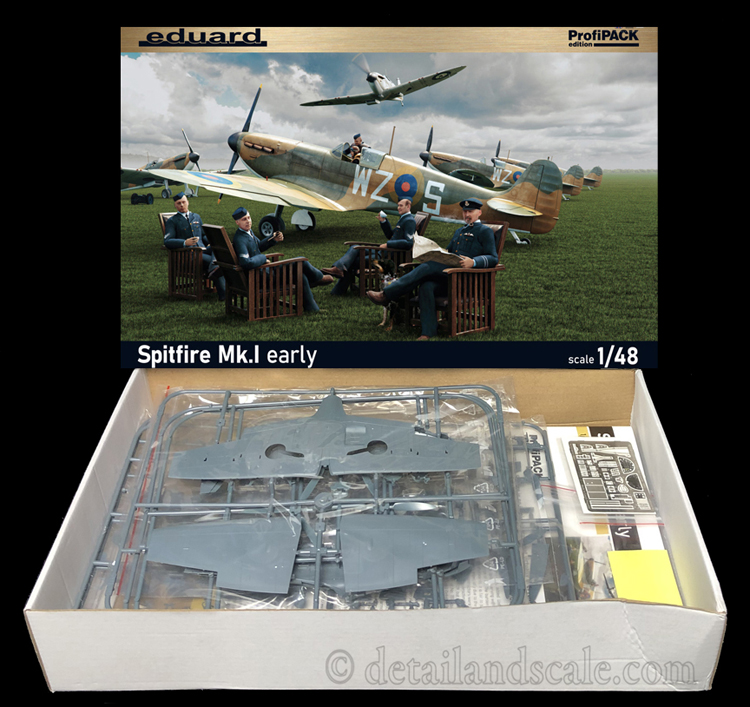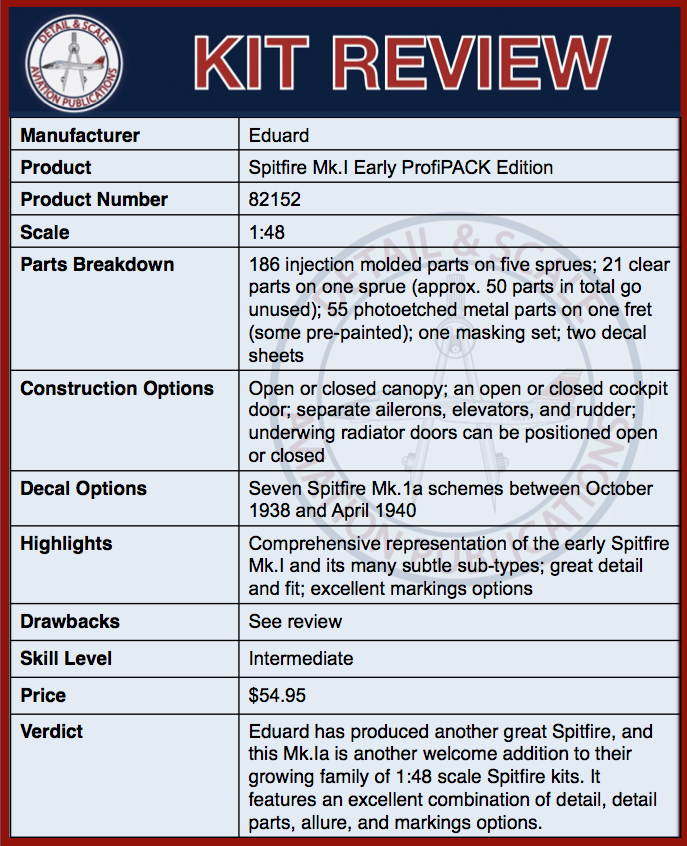Eduard # 82152 Spitfire Mk.I Early ProfiPACK Edition — 1:48 Scale


The legendary Supermarine Spitfire helped turn the tide of the Battle of Britain and shaped the outcome of the rest of World War II in Europe. In August 2020, Eduard premiered their series of 1:48 scale early Spitfires, and since then various early Spitfire kits have been progressively released at a steady pace. Let’s take a look at their Spitfire Mk. I Early ProfiPACK kit.

The origins of the Spitfire date back to 1931 when Great Britain’s Air Ministry released a specification calling for a modern fighter capable of an airspeed of 250 mph. In response, the famous R. J. Mitchell developed the Type 224, an open-cockpit monoplane with gull-wings and large, fixed, undercarriage. However, the competing Gloster Gladiator biplane won that contract. Undeterred, Mitchell developed the improved Type 300 for another new fighter contract in 1935. This narrow-fuselage, elliptical wing design soon became known as the Spitfire, and later that year the Air Ministry placed an order for 310 aircraft.
The Spitfire prototype first flew in 1936, and in in 1938 the first production Spitfire Mk.I took to the air. The Spitfire Mk.I was quite agile. It could reach a maximum speed of 362 mph and climb at nearly 2,500 feet per minute until reaching its service ceiling of 31,000 feet. It was powered by the 1,030 hp Merlin Mk.II engine until the Merlin Mk.III was introduced with the 175th production airframe. The first 77 Mk.Is had a two-blade wooden prop that was superseded by a larger three-blade propeller that notably improved take-off performance, maximum speed, and ceiling. A blown canopy replaced the original flat canopy in 1939 to improve visibility. Beyond these, many dozens of additional small and incremental changes (“fine-tuning”) were implemented over the course of Mk. I production and service lifetime. A total of 1,567 Mk.Is were produced.
The Spitfire Mk.I achieved initial operational status with 19 Squadron at RAF Duxford on 4 August 1938. It was a front-line combat aircraft for 18 months before being replaced by the much-improved Spitfire Mk.V. Yet, in that time, Spitfire Mk.Is contributed invaluably to the war. Its first encounter with the Luftwaffe was at Dunkirk, and the outcome of that engagement demonstrated that the feared Bf 109 had more than met its match. During the Battle of Britain, Spitfire Mk.Is famously defended Great Britain alongside Hawker Hurricanes. The Spitfire was a key factor in repelling the Nazi onslaught above England, and in the years following, it helped defeat the Axis powers in all the major theaters of the war.

Eduard’s 1:48 scale Spitfire Mk.I Early ProfiPACK edition kit contains 186 injection-molded parts on six sprues (about 40 of which go unused here) and 21 clear parts on one sprue (10 of which are not used). Additionally, 56 photoetched metal parts are included on one fret (nine are pre-painted). There is also a pre-cut, self-adhesive masking set and two decal sheets. The full color instruction booklet organizes the build over 15 pages. Markings for seven airplanes are included:
- Spitfire Mk.I K9797, flown by Sgt. George Unwin, No.19 Sqn., RAF Duxford, Cambridgeshire, United Kingdom, October 1938
- Spitfire Mk.I, No.19 Sqn., RAF Duxford, Cambridgeshire, United Kingdom, early 1939
- Spitfire Mk.I K9843, No.54 Sqn., Hornchurch, Essex, United Kingdom, early 1940
- Spitfire Mk.I K9938, No.72 Sqn., Church Fenton, North Yorkshire, United Kingdom, April 1939
- Spitfire Mk.I K9962, flown by S/Ldr. Andrew Farquhar, CO of No.602 Sqn., RAF Abbotsinch, Renfrewshire, United Kingdom, May 1939
- Spitfire Mk.I, No.609 Sqn., Drem, East Lothian, United Kingdom, March 1940
- Spitfire Mk.I, No.602 Sqn., Drem, East Lothian, United Kingdom, April 1940
Strengths: Eduard’s Spitfire Mk.Is build upon a legacy of their later-model Spitfire kits which are arguably the best of their kind in 1:48 scale. Eduard’s very fine interpretation of the Spitfire Mk.I also holds its own against the Tamiya kit on many levels.
What is distinctive in this issue of the Eduard Spitfire Mk.I Early kit? Sprues B and C and a new set of photoetched metal parts cover the subtle differences between Mk.I sub-variants. These parts will be familiar to those who have seen previous releases of this kit. Just sitting in the box, the fuselage and wings shine with an exceptional quality of surface details – just perfection. There’s a combination of beautiful recessed and raised details (raised rivets and fasteners where they should be) that should be very nice to work with. Fabric covered control surfaces display a slightly perceptible roughened texture. I test fitted the major assemblies, and fit appears to be airtight and virtually perfect.
The parts breakdown is quite conventional (left and right fuselage halves, upper and lower wing halves. There is, however, a nice internal wing spar that will help solidify the wings. Construction options include an open or closed canopy, an open or closed cockpit door, and separate ailerons, elevators, and rudder. The control surfaces are engineered to go straight-in, and if the builder wishes to position them in anything other than the neutral position, removal and clean-up of the mounting tabs will be necessary. Underwing radiator doors can be positioned open or closed.
As noted, the kit captures the myriad of small differences among the Mk.I variant, such as with the optional parts for the original plain windscreen and later armored windscreen, the differing antenna configurations, different wheel hub designs, and the original fixed-pitch two-blade propeller or the later Havilland/Rotol three-blade prop. Other small details, such as antennas, antenna wires, gunsights, and even fine differences in the cockpit door latching mechanism are faithfully reproduced and presented as construction options.
The kit cockpit will remind a lot of people of the complexity and detail seen in Eduard’s other 1:48 scale Spitfires as they share a basic design lineage. There is a rather high level of detail and accuracy for an injection molded kit here with the seat, cockpit frame, and sidewall details, but what will really make this cockpit excellent are the beautifully made pre-painted, multi-layer photoetched instrument panel, shoulder harnesses and lap belts, and other detail parts. The exhaust stacks also deserve a mention. Most injection molded exhaust stacks are flat-ended, but here, they are nicely hollowed out. The masking set for the clear parts and wheel hubs is a very nice time-saving feature that will ensure precise masking where it is most needed.
Spitfire Mk.I paint schemes were all quite similar and do not usually feature a lot of variety. Nevertheless, these markings options cover a range of interesting variations with equally interesting backstories within the Mk.I repertoire that all preceded the Battle of Britain. It’s an excellent set of markings options to be sure. Note that the decals are the new style of wet transfer decals.
Weaknesses: I cannot offer any substantive critiques of this kit. Close eyeballing will find a few very minor sink marks on a few parts, but they are small and not particularly noticeable.

Eduard continues to do a great job with the release of their Spitfire Mk.I Early ProfiPACK edition. For those interested in even more detail, Eduard has various detail sets in their Brassin, LööK, and Space product lines. We look forward to the Spitfires that will continue to be released by Eduard in the near future as their family of Spitfire kits continues to expand.
Sincere thanks are owed to Eduard for the review sample. You can visit them on the web at http://www.eduard.com and on Facebook at https://www.facebook.com/EduardCompany
Haagen Klaus
Scale Modeling News & Reviews Editor
Detail & Scale


